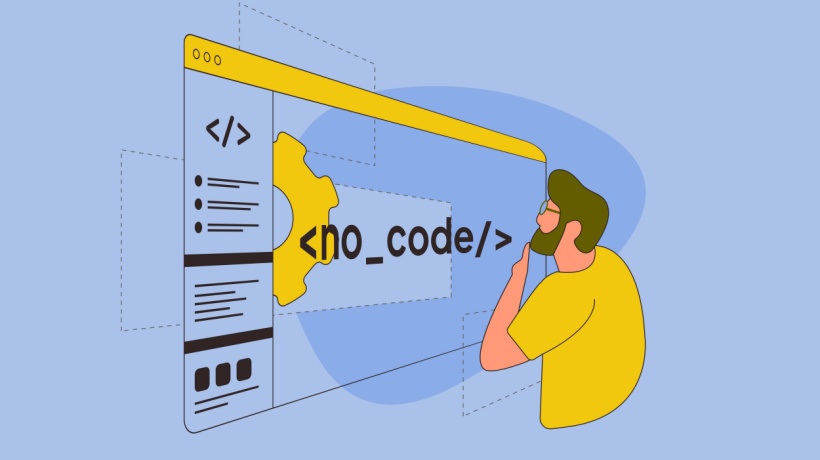The Future Of Learning And Development
Learning and Development (L&D) is no longer confined to training rooms, static LMS modules, or one-size-fits-all approaches. In today's fast-evolving business landscape, continuous learning is a strategic imperative. But the traditional methods of skill-building simply can't keep pace with the dynamic demands of the workforce or the growing complexity of tools, roles, and customer expectations.
Enter the new learning curve—an evolution fueled by the convergence of Artificial Intelligence (AI), no-code development, and human-centered design (HCD). Together, these three forces are reshaping how organizations design, deliver, and personalize learning experiences. The result? Empowered employees, agile L&D teams, and learning journeys that truly fit the flow of work.
Let's explore how this triad is reimagining L&D for the future.
Why Traditional L&D Is No Longer Enough
Before diving into the solutions, it's important to understand the challenges that have plagued traditional L&D:
- Generic content that fails to engage or address individual learner needs.
- Long development cycles for training material that quickly becomes obsolete.
- Low completion and retention rates, often due to poor timing or lack of relevance.
- Overburdened L&D teams who are expected to train diverse teams across regions, roles, and skill levels.
- Disconnected tools and data, making it difficult to track learning effectiveness.
Clearly, there's a need for transformation. But not just any transformation—one that's fast, scalable, personalized, and rooted in empathy.
The Role Of AI In The New Learning Curve
AI is transforming L&D from a reactive function into a proactive force for growth. Here's how.
1. Personalized Learning Paths
AI algorithms analyze user behavior, role, skill gaps, and preferences to recommend content that's relevant, timely, and impactful. Rather than pushing the same curriculum to everyone, L&D teams can now deliver individualized learning journeys that evolve dynamically as the learner progresses.
2. Automated Content Generation And Tagging
Generative AI tools can assist in creating microlearning modules, summarizing lengthy documents, converting text into quizzes, or generating scenarios for soft skills training. This reduces content development time and effort dramatically.
AI can also auto-tag content with metadata—like topic, difficulty, and learning objectives—making it easier to curate and retrieve learning materials.
3. Intelligent Learning Assistants
AI-powered chatbots or virtual coaches are becoming part of many digital learning ecosystems. They can answer learners' questions, recommend next steps, or even simulate role-plays for skills like negotiation or leadership.
4. Predictive Analytics For Learning Outcomes
By tracking learner data across touchpoints—course completions, assessments, engagement—AI can predict outcomes such as knowledge retention, likelihood of course completion, or future skill gaps. This allows L&D teams to act early and optimize programs.
No-Code: Empowering L&D To Build, Not Just Deliver
For years, L&D professionals have relied on IT or third-party vendors to build custom tools, dashboards, and learning experiences. This dependency slowed down innovation and made quick iterations nearly impossible.
That's where no-code development comes in.
What Is No-Code In The L&D Context?
No-code platforms enable users to build applications, workflows, dashboards, and portals using drag-and-drop interfaces and pre-built components—no programming required. For L&D, this means:
- Building custom learning portals, assessment tools, or feedback forms.
- Creating workflow automations (e.g., enrollment triggers, learning nudges).
- Integrating data from LMS, HRIS, or performance systems for deeper insights.
- Rapid prototyping and A/B testing of new learning models or content delivery formats.
Why It Matters
- Agility: No waiting for IT cycles. L&D teams can move at the speed of learning needs.
- Customization: No-code allows organizations to tailor learning solutions to their unique culture, values, and goals.
- Cost-effectiveness: Reduces reliance on expensive external development.
- Innovation: Encourages experimentation with new formats like gamification, spaced repetition, and mobile-first learning.
Human-Centered Design: The Ethical Compass Of L&D Innovation
With AI and no-code providing power and speed, human-centered design ensures the learning experience remains meaningful, inclusive, and empathetic.
HCD is not just about better interfaces—it's a mindset that puts people at the heart of the design process. It focuses on understanding learner motivations, emotions, and behaviors to design learning that resonates and sticks.
Core Principles Of HCD In L&D
- Empathy-driven research: Use interviews, observations, and feedback loops to understand real learner pain points and goals.
- Co-creation with learners: Involve learners in the creation and iteration of content and platforms. This fosters a sense of ownership and improves adoption.
- Inclusive design: Ensure accessibility for all learners—across geographies, abilities, learning styles, and languages.
- Prototyping and Iteration: Start small, test often, and evolve based on real usage. This minimizes risk and maximizes relevance.
- Design for moments that matter: Learning doesn't happen in a vacuum. Design experiences that align with career milestones, performance reviews, or life transitions.
The Power Of The Blend: AI + No-Code + HCD
Individually, AI, no-code, and HCD bring valuable capabilities to L&D. But the real magic happens when they converge.
Imagine this. You're an L&D leader at a fast-growing company. Your team uses:
- AI to identify that junior managers struggle with performance review conversations.
- HCD methods to interview a few managers, uncovering that they fear conflict and lack confidence.
- No-code tools to build an interactive coaching simulation in a week, based on real scenarios.
- AI again to personalize follow-up microlearning based on quiz scores and behavioral data.
This is not a future vision. It's already happening in leading organizations.
Real-World Use Cases
1. Just-In-Time Microlearning
A healthcare organization uses AI to recommend quick three-minute learning bursts on updated safety protocols, depending on the nurse's department and patient load. The L&D team used a no-code platform to deploy these in record time without disrupting clinical workflows.
2. Onboarding Redesign
A tech company revamped its onboarding using HCD interviews, then built a personalized, gamified onboarding portal using a no-code platform. AI recommends modules based on the employee's role and manager feedback. New hires now complete onboarding 30% faster.
3. Upskilling For Citizen Development
L&D teams themselves are learning no-code to become citizen developers. They create internal apps for tracking learning requests, scheduling sessions, and gathering feedback—automating their own workflows and freeing up time for strategy.
Challenges And Considerations
Blending these elements also brings challenges:
- Data privacy: AI systems must be compliant and ethical in handling learner data.
- Skill gaps: L&D teams need upskilling to adopt no-code tools and understand AI outputs.
- Change management: Shifting to agile, learner-first models requires cultural alignment.
- Tool overload: Avoid tech sprawl—choose platforms that integrate well and serve clear goals.
The key is not to chase trends blindly, but to thoughtfully align these tools with your learning philosophy and business objectives.
How To Get Started
If you're ready to explore the new learning curve, here's a phased approach.
Phase 1: Rethink Your Approach
- Run empathy workshops with learners.
- Identify key moments in the employee journey where learning can have the most impact.
Phase 2: Experiment With AI And No-Code
- Use AI tools for simple content generation (e.g., summaries, quizzes).
- Pick a no-code platform and prototype one internal tool—like a feedback tracker.
Phase 3: Measure And Iterate
- Use analytics to track adoption, performance, and engagement.
- Keep learners in the loop—co-create solutions with them.
Phase 4: Scale Responsibly
- Standardize design systems and governance for no-code projects.
- Ensure AI use aligns with ethical standards and DEI goals.
AI Use Cases In L&D By Function
AI is no longer just a tool for data scientists—it's becoming an intelligent co-pilot for L&D teams across functions. From designing learning experiences to ensuring compliance, AI can automate, personalize, and optimize like never before. Let's explore how specific L&D roles and responsibilities are evolving with AI integration.
1. Instructional Design: Faster, Smarter Storyboard Creation
Traditional challenge: Instructional Designers often spend weeks researching, structuring content, writing scripts, and collaborating with SMEs to create storyboards.
How AI helps:
- Content summarization: Feed long-form documents or SME interviews into an AI tool to generate key points or outlines.
- Auto-storyboarding: Tools can generate draft scripts, visuals, and even narration suggestions.
- Multilingual support: AI can instantly translate modules into multiple languages with contextual accuracy.
Impact:
- Cuts storyboard development time by up to 50%.
- Enables rapid prototyping and iteration.
- Frees up Instructional Designers to focus on creativity and alignment.
Example: An L&D team at a healthcare organization uses AI to convert policy updates into compliance-friendly microlearning scripts overnight.
2. Compliance Training: Real-Time Monitoring Of Mandatory Course Completions
Traditional challenge: Compliance training is often viewed as a checkbox exercise with low engagement. Tracking completion across departments is manual and time-consuming.
How AI helps:
- Behavioral tracking: AI can monitor user progress, engagement time, and quiz scores to identify disengaged learners early.
- Predictive alerts: AI flags employees who are at risk of missing deadlines, allowing managers or systems to nudge them proactively.
- Smart reminders: AI adjusts reminders based on learner behavior (e.g., sends alerts when users are most likely to respond).
Impact:
- Ensures higher completion rates without micromanagement.
- Enables proactive rather than reactive compliance enforcement.
- Reduces manual follow-ups by HR or L&D staff.
Example: A financial services firm uses an AI-based compliance tracker that automatically escalates non-completion risks to line managers, improving adherence by 30%.
3. Leadership Development: AI-Driven Scenario-Based Role-Plays
Traditional challenge: Leadership training is hard to scale and often lacks real-world application. Simulations are costly and require human facilitation.
How AI helps:
- Conversational AI role-plays: Leaders interact with AI avatars in simulated conflict resolution, feedback delivery, or negotiation scenarios.
- Emotion and sentiment analysis: AI evaluates tone, pacing, and language to provide feedback on communication effectiveness.
- Adaptive pathways: AI adjusts the simulation complexity based on the leader's responses.
Impact:
- Delivers scalable, realistic soft skills training.
- Provides instant, personalized feedback for improvement.
- Allows practice in a risk-free environment.
Example: A multinational telecom company implemented AI-powered simulations for its mid-level managers to practice giving constructive feedback, leading to a measurable uptick in employee satisfaction scores.
4. Sales Enablement: Custom Learning Paths Based On CRM Performance Data
Traditional challenge: Sales reps often face information overload. Generic training doesn't match fast-changing products or customer dynamics.
How AI helps:
- CRM integration: AI pulls performance data (e.g., call outcomes, deal velocity) to identify individual or team-level skill gaps.
- Targeted training: Reps get nudges to complete micro-courses specific to the objections they're struggling with or industries they're selling to.
- AI coaching: AI tools analyze sales calls and suggest language refinements or confidence boosters.
Impact:
- Increases training relevance, boosting adoption.
- Shortens onboarding for new reps.
- Improves quota attainment with just-in-time upskilling.
Example: An EdTech startup connects AI to their CRM and LMS. If a rep struggles with deals in the education sector, the system recommends a refresher on K-12 buyer personas and case studies automatically.
Conclusion: Learning That Evolves With The Learner
The next era of L&D won't be about more content—it'll be about smarter experiences. By combining the intelligence of AI, the speed of no-code, and the empathy of human-centered design, organizations can build learning systems that are:
- Fast to adapt
- Personalized to each learner
- Inclusive and intuitive
- Agile enough to evolve with business needs
In a world where the only constant is change, this new learning curve is not just an opportunity, it's a necessity.
Let's design learning that grows with people—not just for them.






